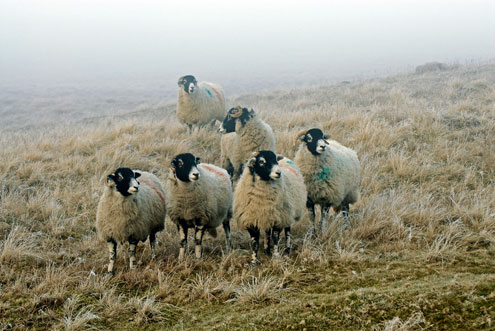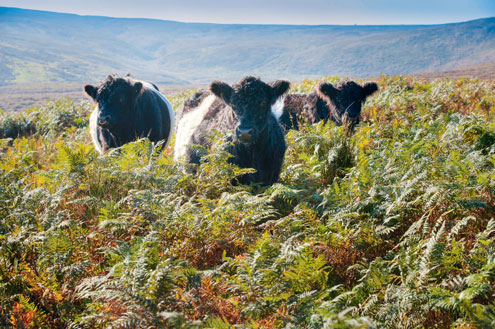Agri-environment schemes working for the upland farmer

Striking a workable balance between farming in the hills and uplands and improving the environment has long been a challenge, and yet it’s one that has all too often left farmers feeling they’ve drawn the short straw.
But things are changing. Recent months have seen a flurry of activity from Natural England – the government body charged with the job of implementing environmental schemes.
It has vigorously engaged with upland livestock farmers to try to achieve better ways of working together and a broader understanding of the real and practical workings of upland farming has been the pay-off – with the results quickly being applied.
And it would seem there are now enticing opportunities for farmers who may have been sceptical about such schemes in the past.
| Fernyford Farm facts |
|---|
| Fernyford Farm extends to 62ha in a ring fence, the majority of which is in the Leek Moors SSSI. There is also grazing on adjacent SSSI moorland. Environmental management focuses on breeding waders – lapwing, snipe and curlew – and developing species-rich hay meadows. The different wader species have specific habitat requirements and the farm is managed accordingly to create wet, rushy pastures with a good amount of cover for snipe, while lapwings require short, open swards with good visibility to spot predators. Mr Richardson has undertaken innovative work within the agreement and created “plough plots” to attract lapwing, as well as creating feeding areas for waders, contour ditches, scrapes and reprofiling ditches. Hay meadows are managed to enhance species diversity using seed from local meadows that still support the range of species indigenous to the area. |
Dartmoor Farming Futures scheme
There can be no better flagship for Natural England’s newfound awareness than the Farming Futures scheme already under way on Dartmoor – and there are plans to replicate similar schemes elsewhere. In its broadest terms, the Farming Futures approach to delivering environmental packages on Dartmoor hill farms gave the farmers the opportunity to do it “their way”.
While Higher Level Scheme (HLS) agreements continue to form the benchmark for what is required on individual Dartmoor farms, each farmer is made aware of the aims of his/her agreement and how it can be quantifiably delivered. But the way in which those goals are achieved in practical management terms is left to the individual. Should environmental targets not be met, the original prescriptions of the HLS agreement come back into play.
Lake District changes
In the Lake District, where extensive destocking of the fells has been one of Cumbrian farming’s most controversial issues for almost two decades, a team of Natural England staff have recently spent a week working alongside fell farmers. It’s hoped this will begin to lessen the criticism levelled at Natural England that those who have the day-to-day job of applying environmental agreements don’t understand enough about the practicalities of running large sheep flocks on heather fell.
Lake District hill farmer Will Cockbain, who was the NFU’s national spokesman on the uplands for eight years, is now a non-executive board member of Natural England. He says recent months have seen Natural England looking at better ways of working with uplands farmers to deliver what he describes as “optimal land use”.
“I believe optimal land use can produce benefits for the environment and ensure their long term sustainability and their skills base,” says Mr Cockbain.
“Government upland policy is now about food production and the environment being in unison and setting goals that upland farmers can deliver. There are innovative schemes being introduced that are more outcome-focused, such as the scheme on Dartmoor where farmers are given more freedom to deliver those outcomes, rather than being tied to a rigid prescriptive package.”

Peak District – managing the environment
The Peak District National Park attracts millions of visitors a year to enjoy its upland landscape, and at its heart is Fernyford Farm, near Buxton. This upland beef and sheep unit has been managing the environment within a thriving farming business and is clear proof of the way the two primary aims of the uplands can be met.
Stone walls and historical landscape features are the essence of this region, but applying practical farm and stock management approaches to areas of habitat under threat has been the focal point of the HLS agreement now under way at Fernyford Farm – mostly focusing on the re-establishment of the rich environment within in-bye land at about 900ft.
Neil Richardson runs the successful upland unit with his wife Dorota and carries Swaledale sheep and Belted Galloway cattle.
Although the farm is renowned for producing top-quality Swaledale tups, the farm’s cattle have undergone a major change from Limousin, Blonde and British Blue to Belted Galloway. It’s a move that not only provides the farm with an invaluable “grazing tool” to use on environmentally-sensitive “rushy” pasture, but has also given the Richardsons a premium-value beef product that is now retailed direct from the farm.
Fernyford Farm has 60.7ha of in-bye of which 40.4ha are classified as SSSI and are under a HLS agreement. On the farm’s moorland grazing at 1,000-1,200ft, the Peak District National Park has recently fenced off three blocks of land – about 56.6ha each – to allow controlled grazing to eat off unwanted vegetation.
The HLS in operation on the in-bye is achieving controlled grazing by Galloway cattle to improve the invasion of rushes and molinia. But the scheme running on the moorland is at the request of Mr Richardson in a bid to return stock to areas of heather moor that have suffered from under-grazing for more than 30 years.
“These areas were destocked 30 years ago. There was no gamekeeper and the idea of the Peak District National Park Authority was to manage it for birds. Previously it had been farmed and shot over, but when the traditional management structure associated with this was dismantled, the bird life disappeared.
“This farm was famous for having the largest population of black grouse in England. Now there are none. There are crows and magpies and foxes, but no grouse and no gamekeeper,” says Mr Richardson.
When he took over the tenancy 25 years ago, he said the environmental agreement was “totally unmanageable.”
“Natural England have now been working closely with me and we have changed things dramatically to make it workable for the farm and yet still remain beneficial for the birds.”
The original agreement on the SSSI in-bye imposed no grazing with stock before 1 August and all stock to be off the land by 1 November.
“We had one cow in this field and two cows in that field. Late grazing and late mowing with rushes as high as the tractor. It was achieving nothing for the bird life,” says Mr Richardson.
In 2004, the farm changed to Belted Galloways and Natural England agreed to let the cattle graze all year round. “When Natural England came in the spring after the cattle had been outwintered on this land, they were amazed at the job they’d done. They’d thrived and cleaned out the rushes into the bargain and the snipe and curlew returned.”
But there’s still room for improvement in the way some agreements enforce stock withdrawals during part of the year. “Trying to find somewhere to put sheep during winter is becoming very difficult unless you’ve got a long-standing arrangement. There’s no grass left after the cold and wet summer where we could put them, so we’ll have to bring them inside and put them on haylage.”
